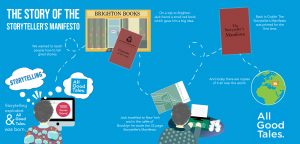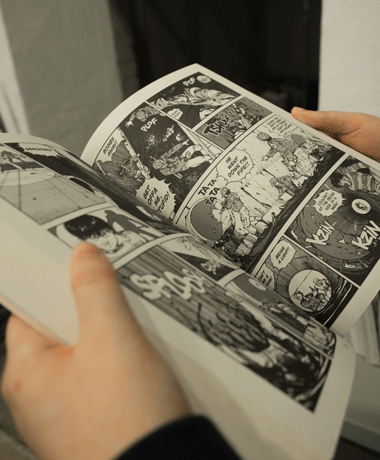When you’re trying to tell a story on social media, grabbing your audience’s attention is no easy task. But with every post and status you publish you have to ask yourself how are you going to rise above the competition?
When you’re presented with a timeline full of text–facts, figures and copy, it’s likely most of the information you’re reading isn’t going to stick. However, the monotony of text can be broken up with some images, gifs, and infographics as light relief. Images can also evoke emotions in a way that text can’t.
The purpose of brand storytelling is to connect with your audience and evoke an emotional reaction to the story you’re telling.
Here are five ways to boost your visual storytelling on social media:
Use infographics to help tell your story
Here at All Good Tales, we have a little booklet called the Storyteller’s Manifesto that helps you unlock your stories. It can be requested here. Our CEO and founder Jack Murray had the idea for the Manifesto when he picked up a historic army manual in Brighton. The manual accompanied him on a trip to Brooklyn where he spent his time writing the manifesto. The text and the inspiration were given to our designer to create the Storyteller’s Manifesto as we know it today.

Here is a prime example of a story or process that wouldn’t have fit in with the Twitter character limit. But do you know what will? An infographic. Our brilliant in-house multimedia specialist Áine designed this beautiful graphic that explains how the manifesto was created and can be shared easily across all social media platforms without much need for an explanation.
Infographics are a great way to boost your visual storytelling particularly for displaying facts and figures.
Images don’t have to be complex
Humans of New York (HONY) is one of the best examples of the power of a simple image. The image is always accompanied by emotional and thought-provoking stories from real people on the streets of New York.
Brandon Stanton is the owner of the now world-renowned blog. He started his career as a Bond trader in Chicago. On weekends would find happiness in taking photographs of the landscape around the city. After he was fired from his job, he packed his bags and moved to New York.
Along with HONY, he is now a bestselling author and photographer.
Stanton shows the true power of an image and how it can capture the emotion of not only the person telling the story but also the audience reading.
While Stanton posts the stories across many different platforms, it’s Facebook and Instagram that have grown the biggest following, (18 million and 8 million followers respectively). This is possibly due to a lack character limit. This allows the story to be fully developed accompanying the image.
We’ve previously featured HONY as part of our Passionate About Stories series, check it out here.
Visuals should be tailored for each social platform
Instagram, Twitter, Facebook and LinkedIn all support visual content. However, the type of content that is suitable for each platform is very different.
Depending on your company voice, a story you tell on Twitter might not be suitable for your Facebook audience and vice versa. Similarly, a chatty Instagram story mightn’t work for your LinkedIn post depending on the context.
It’s important to keep in mind that while every platform requires different types of content or posts, they all need to be in line with your brand’s messaging and have the same voice. When users see your content they should instantly recognise the tone and design of the post as your brand.
